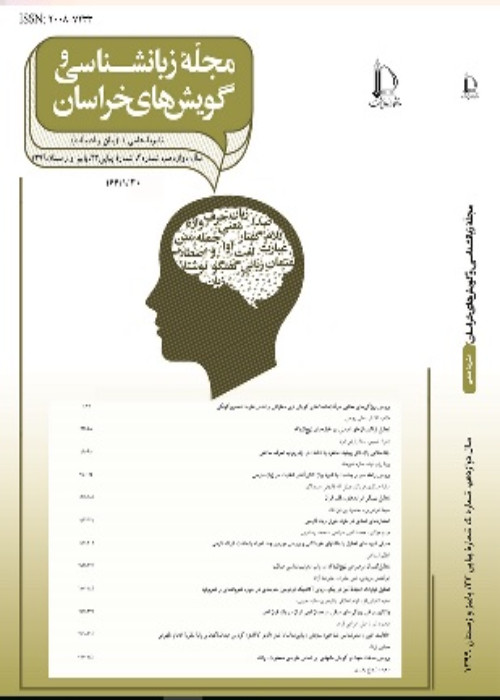THEME in Persian and English: A Typological Study
Author(s):
Article Type:
Research/Original Article (دارای رتبه معتبر)
Abstract:
Introduction
In generalizing/partial typology, which has been the dominant approach in typology since the early 1960s, achieving language universals was the main concern. It is noteworthy that in this approach, achieving language generalizations is based on interlanguage comparison of specific structures such as causativization, passivization, and possession. Following the generalizing/partial typology approach within the systemic functional grammar, Matthiessen (2004) has sought to achieve language generalizations. In fact, having examined the ideational (logical and experiential), interpersonal, and textual systems of the ‘clause grammar’ of different and various languages, Matthiessen (2004) has achieved a series of typological generalizations/universals in the framework of systemic functional typology. It should be noted that these generalizationsrefer both to divergences (differences) and convergences (similarities) of language systems. In terms of his proposed typological generalizations, Matthiessen (2004) has argued that they can be applied in the description of any language and in the attempt to expand the typological explanations in the framework of systemic functional grammar as well. However, he has immediately stated that “It is not yet possible to propose a generalized map; but we have to move in that direction.”
In line with Matthiessen’s claim mentioned above, the present paper has attempted to describe the THEME system of Persian language on the one hand and to compare it with the THEME system of English as the dominant foreign language in the area of education in Iran, on the other hand.
Theoretical Framework
This study has been conducted in the framework of systemic functional typology and specifically Matthiessen (2004) ’s typological generalizations in terms of the THEME system [1]. Matthiessen (2004) has identified the following areas as the principal parameters of typological variation in the THEME system of languages: (1) The treatment of unmarked and marked THEME, (2) The relationship between THEME and INFORMATION, (3) The relationship between THEME and MOOD, (4) The relationship between experiential (topical) THEME and interpersonal and textual THEME, and (5) The relationship between THEME and VOICE.
In this research, in order to limit its scope, only three of the above domains have been selected as typological parametersfor describing the THEME system of Persian language and comparing it with the THEME system of English: (1) The treatment of unmarked and marked THEME (related to the subsystem of THEME MARKEDNESS), (2) The relationship between THEME and MOOD (related to the subsystem of THEME SELECTION), and (3) The relationship between experiential (topical) THEME and interpersonal and textual THEME (related to the subsystems of THEME TYPE, INTERPERSONAL THEME, and TEXTUAL THEME).
Methodology
This research is a ‘theoretical fundamental’ type in terms of aim and is a ‘pure descriptive’ type in terms of nature and method. Persian examples of this study have been obtained from various documents such as novel, research papers, and grammar books. However, some of the Persian examples have been made by the authors of this paper. English examples have been mainly taken from Halliday (2005) and Halliday and Matthiessen (2014). It is necessary to note that this research has described the THEME system only within the limits of the simple clause and has avoided dealing withclause complexes.
Results and Discussion
Studying typological behaviors of the Persian THEME system in the framework of Matthiessen (2004) ’s typological generalizations and comparing those behaviors with the typological behaviors of the English THEME system showed that the two Persian and English languages (1) have similar thematic structures; Theme occurs in the initial position of the clause without any Theme marker, (2) treat both unmarked and marked Themes similarly; both marked and unmarked Themes occur in the initial position of the clause with the sequence ‘unmarked Theme + marked Theme’, (3) mark absolute Themes segmentally; Persian absolute Themes are marked by the postposition »ra «and English absolute Themes are marked by prepositions like» as to, as for, regarding«, (4) have both simple and multiple types of Themes; Theme can contain textual and interpersonal elements beside experiential one, and (5) treat the elements of a multiple Theme similarly; the elements making up a multiple Theme have all the same realizations, that is they are realized by the initial position of the clause. Another finding was that unlike English language whose THEME system is MOOD-bound, Persian language possesses a MOOD-free THEME system; in Persian language, unlike English, Subject (whetherpresent or dropped) is the unmarked Theme in all clause types except imperative clause.
Conclusion and Suggestions
The results of this study indicated that the two languages of Persian and English behave similarly in terms of three typological parameters out of four ones related to the THEME system. The finding number (3) as mentioned above, showed that Matthiessen (2004) ’s convergence generalization in terms of THEME system, i. e. the possibility of marking Theme segmentally, is also true of Persian language.
In the end, it is suggested that the typological behaviors of the THEME system of other languages spoken in Iran should be identified and introduced in the aforementioned framework.Keywords:
Language:
Persian
Published:
Journal of Linguistics & Khorasan Dialects, Volume:10 Issue: 18, 2018
Pages:
21 to 53
magiran.com/p1934114
دانلود و مطالعه متن این مقاله با یکی از روشهای زیر امکان پذیر است:
اشتراک شخصی
با عضویت و پرداخت آنلاین حق اشتراک یکساله به مبلغ 1,390,000ريال میتوانید 70 عنوان مطلب دانلود کنید!
اشتراک سازمانی
به کتابخانه دانشگاه یا محل کار خود پیشنهاد کنید تا اشتراک سازمانی این پایگاه را برای دسترسی نامحدود همه کاربران به متن مطالب تهیه نمایند!
توجه!
- حق عضویت دریافتی صرف حمایت از نشریات عضو و نگهداری، تکمیل و توسعه مگیران میشود.
- پرداخت حق اشتراک و دانلود مقالات اجازه بازنشر آن در سایر رسانههای چاپی و دیجیتال را به کاربر نمیدهد.
In order to view content subscription is required
Personal subscription
Subscribe magiran.com for 70 € euros via PayPal and download 70 articles during a year.
Organization subscription
Please contact us to subscribe your university or library for unlimited access!



